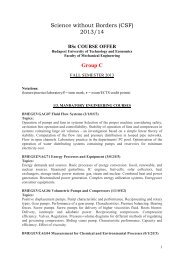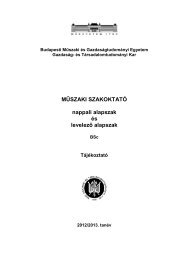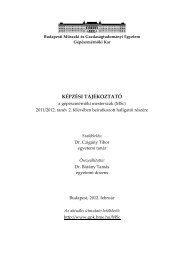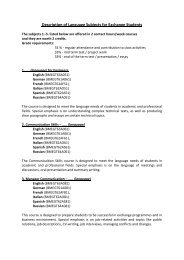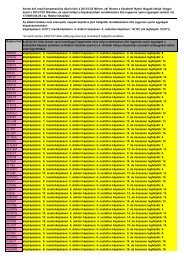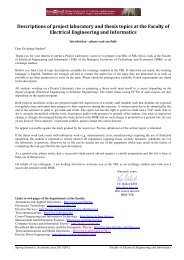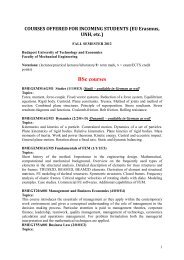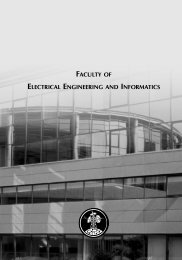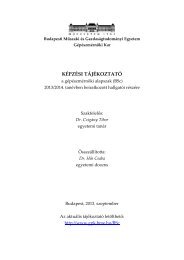FACULTY OF CHEMICAL TECHNOLOGY AND BIOTECHNOLOGY
FACULTY OF CHEMICAL TECHNOLOGY AND BIOTECHNOLOGY
FACULTY OF CHEMICAL TECHNOLOGY AND BIOTECHNOLOGY
Create successful ePaper yourself
Turn your PDF publications into a flip-book with our unique Google optimized e-Paper software.
<strong>FACULTY</strong> <strong>OF</strong> <strong>CHEMICAL</strong> <strong>TECHNOLOGY</strong> <strong>AND</strong> BIO<strong>TECHNOLOGY</strong>Energy production with conventional andnovel methodsBMEVEKFM302Dr. György PátzayEnergy definitions, role of energy, forms of energy. Energytransformations, efficiencies, losses. Energy resources, technicalsystems in energetics, Energy supply in the world, EU andHungary. Fossile energy resources and transformation technologies.Environmental and economical aspects. Fuels. Gashydrates. Energy statistical data, tendencies, resources andreserves. Energy transportation and storage technologies.Renewables and their future role. Carbon dioxide capturetechnologies. Thermodynamic aspects of energy productionCarnot, Rankine and Brayton cycles. Efficiencies and developmenets,cogeneration and combined cycles. Water in energyproduction. Role of hydrogen int he future energy production.Heat pumps and fuel cells. Nuclear energy production,fission and fusion.Modern Separation TechnologiesBMEVEKFM104Dr. Edit SzékelySeparaion technologies in vacuum: sublimation, liofilisation,short path distillation, molecular distillation. Membraneseparation: microfiltration, ultrafiltration, nanofiltration,reverse osmosis, gaspermeation, pervaporation, membranedistillation,liquid membranes, modeling and scale up.Supercritical fluids: GRAS (generally regarded as save) solvents,physio-chemical properties of supercritical solvents, high pressurephase-equilibria, extraction and separation, connection toother separation processes, fractionated separation, preparativesupercritical fluid chromatography (simulated moving bedchromatography), modeling and scale up. Applications inchemical, food and pharma industries, in biotechnology andenviromental applications. Special applications.Industrial Organic ChemistryBMEVESZM204Dr. György Keglevich, Dr. Alajos GrünSystematic discussion of the most important basic processesin industrial organic chemistry, such as alkylation, acylation,halogenation, nitration, sulfonation, oxidation, reduction,hydrogenation, hydroformylation, reactions with CO, diazotationand coupling.. The role of technological parameters likestirring, temperature, cooling, portioning of the reactants, pressure,shift of equilibrium. Connection of basic processes toform technologies on the example of processing poliuretanes,epoxy resins and a few effective substances of drugs.PetrochemistryBMEVEKFM402Dr. György PátzayIntroduction, raw materials arising from the crude oil distillation,natural gas utilization in the chemical industry, synthesisgas production, steam-cracking, processing of its products,methanol synthesis, formaldehyde production, carbonylationof methanol, MTBE, ETBE, oxo-synthesis, acetaldehyde,acetic acid, vinylacetate, metacrylate, vinylchloride,ethylene oxide-glycol-ethanolamine, propylene oxide, acrylonitrile,butadiene, isoprene, linear olefins, ALFOL, SHOP.Processing of aromatic compounds, benzene-cyclohexane,phenol-cyclohexanone, PAH, TPA, MAA, adipic acid,hexamethylene diamine, caprolactam.At the lab practice the students get individual tasks, theycollect information about one process, they carry out measurementsin a lab-scale apparatus, evaluate the results andreport about them in written and oral form at the end of thesemester.Branch of Industrial PharmaceuticsPesticidesBMEVESZM403Dr. Imre PetneházyThe subject gives an overview in the most important basicknowledge.The most important herbicides, insecticides andfungicides are discussed together with the synthetic proceduresof the agents and a short description of the agent's biologicaleffect. Synthetic methods for carbonic acides derivatives,phosphoric esters and heterocyclic compounds will bediscusse in detail. The basic formulation methods and enviromentalaspects will also be mentioned.Pharmaceutical TechnologyBMEVESZM202Dr. Zoltán HellComparison of different production strategies of a pharmacologicallyactive substance. Modification of the technologiesfor the sake of the raw material source, of the thrift, of newoperational methods, etc.) Environmental safety in the productionof pharmacologically active substances, the questionsof the reusability of solvents and reagents. Technologicaland operational problems during the production. The studentscan design synthesis lines for a selected active compound.Formulation of Biologically Active MaterialsBMEVESZM404Dr. György MarosiIntroduction, basic terms, mechanisms of biological transport,toxicological aspects in the technology of pharmaceuticalsand other biomaterials, classification of the products,characteristics of incoherent, coherent systems consideringtheir characteristic materials, control of drug-release, qualitative,quantitative and structural analysis. Sustained and controlledrelease from capsules, micro- and nanocapsules,implants, transdermal systems, products of ophtalmology andinhalation aerosols. Technology of aseptic production, packagingof pharmaceutical products.Industrial Organic ChemistryBMEVESZM102Dr. György Keglevich, Dr. Alajos GrünA short summary is offered on the most important basicprocesses used in the pharmaceutical industry. These arealkylations, acylations, sulfonations, nitrilations, halogenations,reductions, oxidations and special transformations. Thepossibilities for the application of the basic processes are discussedin details via the relevant steps of the synthesis ofmedicinal effective substances. C-, O-, and N- alkylations, O-and N- acylations, chlorosulfonations, reductions, hydrogenations,oxidations, Darzens condensations, cyclinationsand special transformations are discussed. A special stress islaid on the point of views of the selection of the appropriatesynthetic methods and on environmental friendly approaches.Medicinal ChemistryBMEVESZM203Dr. Ferenc FaiglFundamental conceptions in medicinal chemistry.Communications among the human cells, primary and secondarymessengers. The four families of receptors, mechnismof function. Dugs of neurotransmitters and their receptors.Drugs of hormons and their receptors. Other mechanisms ofdrug action. Cell membranes, drug actions on the nucleic81



